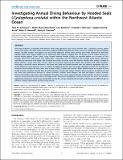Files in this item
Investigating annual diving behaviour by Hooded seals (Cystophora cristata) within the Northwest Atlantic Ocean
Item metadata
| dc.contributor.author | Andersen, Julie Marie | |
| dc.contributor.author | Skern-Mauritzen, Mette | |
| dc.contributor.author | Boehme, Lars | |
| dc.contributor.author | Wiersma, Yolanda F. | |
| dc.contributor.author | Rosvig-Asvid, Aqqalu | |
| dc.contributor.author | Hammill, Mike | |
| dc.contributor.author | Stenson, Garry | |
| dc.date.accessioned | 2013-11-29T17:01:03Z | |
| dc.date.available | 2013-11-29T17:01:03Z | |
| dc.date.issued | 2013-11-25 | |
| dc.identifier.citation | Andersen , J M , Skern-Mauritzen , M , Boehme , L , Wiersma , Y F , Rosvig-Asvid , A , Hammill , M & Stenson , G 2013 , ' Investigating annual diving behaviour by Hooded seals (Cystophora cristata) within the Northwest Atlantic Ocean ' , PLoS One , vol. 8 , no. 11 , e80438 . https://doi.org/10.1371/journal.pone.0080438 | en |
| dc.identifier.issn | 1932-6203 | |
| dc.identifier.other | PURE: 28385286 | |
| dc.identifier.other | PURE UUID: 6c85dcb2-cd44-445e-a8ac-54d08a6a2db1 | |
| dc.identifier.other | Scopus: 84894225498 | |
| dc.identifier.uri | https://hdl.handle.net/10023/4228 | |
| dc.description | This work was funded through the Atlantic Seal Research Programme, International Governance Programme (DFO), the Greenland Institute of Natural Resources, and a CFI grant to YFW. The authors also acknowledge the support of the Marine Alliance for Science and Technology for Scotland (MASTS) pooling initiative in the completion of this study. MASTS is funded by the Scottish Funding Council (grant reference HR09011) and contributing institutions. The funders had no role in study design, data collection and analysis, decision to publish, or preparation of the manuscript. | en |
| dc.description.abstract | With the exception of relatively brief periods when they reproduce and moult, hooded seals, Cystophora cristata, spend most of the year in the open ocean where they undergo feeding migrations to either recover or prepare for the next fasting period. Valuable insights into habitat use and diving behaviour during these periods have been obtained by attaching Satellite Relay Data Loggers (SRDLs) to 51 Northwest (NW) Atlantic hooded seals (33 females and 18 males) during ice-bound fasting periods (2004−2008). Using General Additive Models (GAMs) we describe habitat use in terms of First Passage Time (FPT) and analyse how bathymetry, seasonality and FPT influence the hooded seals’ diving behaviour described by maximum dive depth, dive duration and surface duration. Adult NW Atlantic hooded seals exhibit a change in diving activity in areas where they spend >20 h by increasing maximum dive depth, dive duration and surface duration, indicating a restricted search behaviour. We found that male and female hooded seals are spatially segregated and that diving behaviour varies between sexes in relation to habitat properties and seasonality. Migration periods are described by increased dive duration for both sexes with a peak in May, October and January. Males demonstrated an increase in dive depth and dive duration towards May (post-breeding/pre-moult) and August–October (post-moult/pre-breeding) but did not show any pronounced increase in surface duration. Females dived deepest and had the highest surface duration between December and January (post-moult/pre-breeding). Our results suggest that the smaller females may have a greater need to recover from dives than that of the larger males. Horizontal segregation could have evolved as a result of a resource partitioning strategy to avoid sexual competition or that the energy requirements of males and females are different due to different energy expenditure during fasting periods. | |
| dc.language.iso | eng | |
| dc.relation.ispartof | PLoS One | en |
| dc.rights | © 2013 Andersen et al. This is an open-access article distributed under the terms of the Creative Commons Attribution License, which permits unrestricted use, distribution, and reproduction in any medium, provided the original author and source are credited. | en |
| dc.subject | Hooded seals | en |
| dc.subject | Feeding migrations | en |
| dc.subject | Habitat use | en |
| dc.subject | Diving behaviour | en |
| dc.subject | Satellite Relay Data Loggers (SRDLs) | en |
| dc.subject | General Additive Models (GAMs) | en |
| dc.subject | First Passage Time (FPT) | en |
| dc.title | Investigating annual diving behaviour by Hooded seals (Cystophora cristata) within the Northwest Atlantic Ocean | en |
| dc.type | Journal article | en |
| dc.description.version | Publisher PDF | en |
| dc.contributor.institution | University of St Andrews. School of Biology | en |
| dc.contributor.institution | University of St Andrews. Scottish Oceans Institute | en |
| dc.contributor.institution | University of St Andrews. Marine Alliance for Science & Technology Scotland | en |
| dc.contributor.institution | University of St Andrews. Sea Mammal Research Unit | en |
| dc.identifier.doi | https://doi.org/10.1371/journal.pone.0080438 | |
| dc.description.status | Peer reviewed | en |
This item appears in the following Collection(s)
Items in the St Andrews Research Repository are protected by copyright, with all rights reserved, unless otherwise indicated.

